Introduction |
Formats |
Printings |
Dies |
Paper |
Straight Edges |
Coils |
Fakes |
Forgeries |
Terminology |
Varieties |
Cancellations |
Rates |
Bibliography
Plate and Printing Varieties
1. Plate Varieties
Plate varieties are differences between otherwise identical stamps produced by markings or repairs or defects on the plate or plates used to print them. For the engraving or intaglio process used to print Admiral stamps, plate varieties may be due to:
- Die differences. As discussed under dies, several Admiral stamps were printed from two dies. Other Admiral stamps were printed from dies that were retouched or re-engraved.
- Relief breaks and wear. A stamp design is impressed on the plate from one or more reliefs on one or more transfer rolls. A transfer roll is a small steel cylinder on which are impressed in relief several copies of the stamp design (typically six for Admiral stamps). The relief impressions are transferred from the die. Each relief is used to lay down one or more plates. Some reliefs wore down noticeably with use. On the 3¢ brown stamp, gouges were deliberately made in the frame of the stamp design on several reliefs, producing the so-called "file mark" varieties.
- Plate markings. To determine the precise position of each stamp on a plate, the siderographer inscribes a set of horizontal and vertical guidelines on the plate, and punches a guide dot at the points where the guidelines intersect. After serving their purpose, the guidelines are usually burnished off the plate. Guide dots are usually hidden by elements of the stamp design. In some cases, however, guidelines and guide dots are still visible on the issued stamps.
- Repairs to stamp impressions. The siderographer may decide to strengthen a stamp impression on a plate by retouching elements of the design by hand or by using the relief to re-enter parts of the design.
- Plate damage. Plates may develop cracks as they are bent, undergo wear over the course of several printings, or become pitted or scratched through mishandling.
Plate varieties are constant: they ostensibly occur on every sheet printed from the plate. In reality, this is not always true. A plate flaw such as a scratch may occur part way through a printing, it may wear off as the plate is used, or it may be repaired at some point while the plate is in use.
Plating enthusiasts like to identify the exact plate and position of each plate flaw. Admiral collectors use a shorthand notation to specify the position.
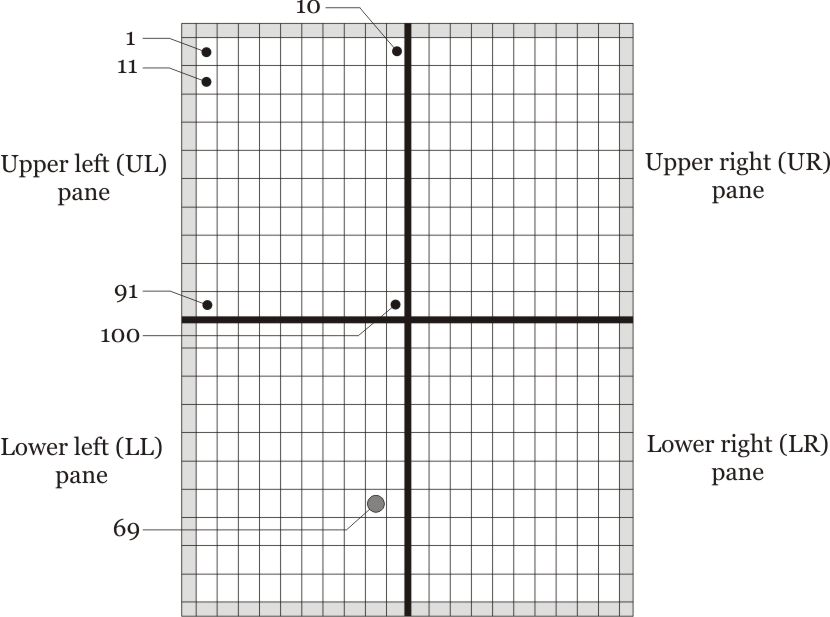
The diagram above shows a sheet of 400 stamps, four panes. The position of each pane is identified by its quadrant on the sheet (for example, UL = Upper Left). The stamps on a pane are numbered from 1 in the upper left corner to 100 in the lower right corner. All the stamps in a row are numbered before moving to the next row down.
Suppose that the sheet in the sketch was printed from plate 161. Then, the position of stamp with the large grey dot in row 7, column 9, of the lower left pane would be 161LL69. Occasionally, the row and column are identified explicitly, like so: 161LL7/9.
Die and relief differences occur on multiple stamps and multiple plates. In contrast, markings, repairs, and damage are unique to one stamp on one plate. Of course, flaws such as guide dots and plate cracks may occur on multiple stamps and multiple plates, making it difficult to identify the position of a specific instance.
Several types of plate varieties are illustrated below.
1.1 Re-entry
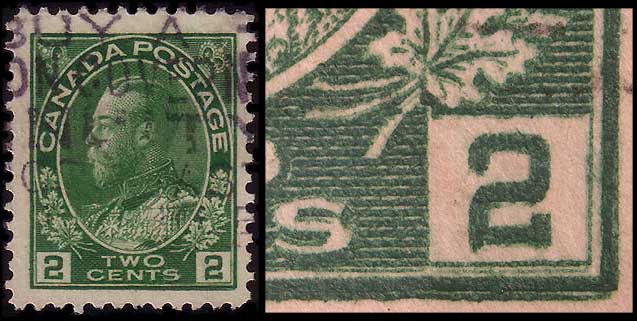
When a printing plate is being made, each stamp subject is carefully entered into its correct position on the plate from a relief on a transfer roll. As the transfer roll is carefully rolled back and forth under pressure on the surface of the plate, the stamp design is gradually impressed into the printing plate. If everything goes right, every line and dot in the stamp design will transfer to the plate. If there is some slight movement which brings the transfer roll out of alignment with the lines of the already partially transferred stamp design, some lines will be doubled or partially doubled.
On the 2¢ green illustrated above, you will notice the doubled lines at the lower right corner of the stamp:
- The lower right frame line
- Under the numeral box
- The S of CENTS
- Even the 2
This re-entry comes from plate 161, lower left pane, stamp number 69; that is, it comes from 161LL69, the position shown as an example in the sketch above.
An in-depth look at re-entries on Canadian stamps can be found at https://re-entries.greenefoundationarchive.ca/.
1.2 Retouch
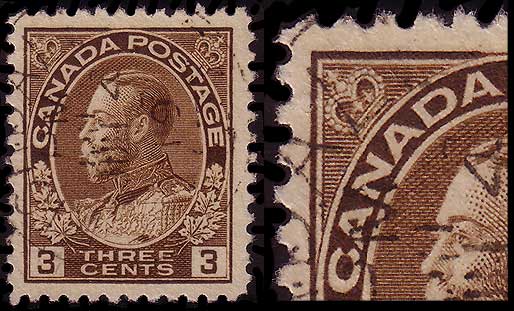
There are times when a printing plate is "touched up" by hand with an engraving tool. When this happens, the plate and stamps are said to have been retouched. Usually lines are strengthened when a plate is retouched. The stamp shown above has been retouched in the upper left spandrel (the "triangle" with the crown in it). The line along the left side of the spandrel is heavy from the bottom corner up to the crown, and the curved line is heavy from the bottom corner to just past the base of the crown.
Retouched stamps are fairly common on the Admirals. The stamp illustrated above is from plate 23 which had every stamp in the UL and LL panes and the first 3 columns of the UR and LR panes retouched. Other Admiral denominations that had printing plates extensively retouched are the 2¢ carmine (plates 117-118), 5¢ violet (plates 19-20), 7¢ bistre (plates 3-6), 20¢ (plate 9), and the 2¢+1¢ carmine War Tax stamp (plates 1-4, 7-8).
1.3 Incomplete Transfer
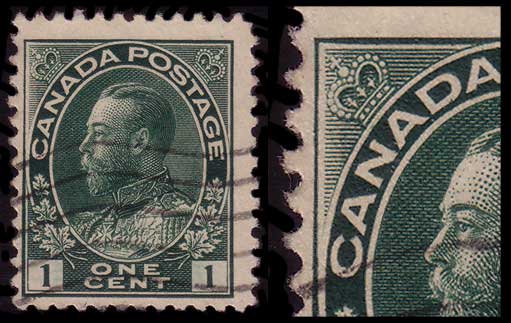
This variety is known as an incomplete transfer because part of the stamp design did not get completely transferred from the transfer roll to the printing plate. Perhaps the surface of the plate was a bit lower at this point, or perhaps uneven pressure was applied to the transfer roll.
You will notice on the stamp pictured above that the lines in the upper left corner seem to get lighter and fade out as they get nearer to the left frame line. Closer examination reveals that they are thinner and there is more white space in between them. Both the left frame line and the top frame line get noticeably thinner as well. This is because these lines on the printing plate are not as deep as they should be, and consequently they appear thinner.
1.4 Hairline Cracks

Most Admiral plates were bent into an arc for use on a sheet-fed rotary printing press. The bending imposes some stress on the steel plates. In some cases, the plate develops fissures or hairline cracks that run along the axis of rotation. Ink gets into these cracks, and they show up on the stamps printed from the plate as fine (usually) lines known as hairlines.
Usually these hairlines just extend horizontally from the corners of the stamp design. On a few plates used to print booklet panes, the hairlines run vertically because the plates were bent around a vertical axis and fitted sideways (relative to the stamp designs) on the press.
Plate 4 of the 2¢ carmine is noted for its extensive set of pronounced hairline cracks. As shown above, the hairlines occur everywhere and run through the stamp design. Other plates with extensive hairline cracks are plates 7, 56, 57, and 58 of the 1¢ green and plates 51 and 52 of the 2¢ carmine.
1.5 Plate Scratch

From time to time, printing plates get scratched. These scratches appear on the stamps printed from it. The stamp shown above has a long scratch in the top margin.
2. Printing Varieties
The previous varieties shown on this page are constant plate varieties because their source is a flaw on the printing plate. There are other varieties that can be loosely termed "printing varieties" because they occur while the stamps are being printed. The printing plates can be over-inked or under-inked. A corner of the paper can become folded which results in stamps being printed on the back of the fold-over (if folded up), or no printing at all (if folded under). Other non-constant printing varieties include paper creases, ink smears, kiss prints, perforation shifts, and mis-cut booklet panes and coils.
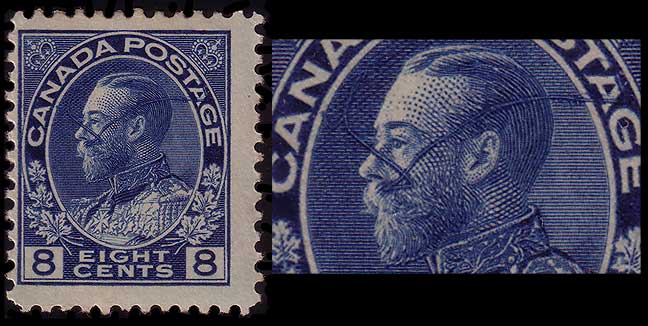
The plate of the stamp pictured above had a long piece of thread or string on it when this stamp was printed. This is not a constant variety because the piece of thread was likely wiped off the printing plate when it was re-inked for the next sheet of stamps.
Introduction |
Formats |
Printings |
Dies |
Paper |
Straight Edges |
Coils |
Fakes |
Forgeries |
Terminology |
Varieties |
Cancellations |
Rates |
Bibliography